Deciphering labels with icons on clothes for washing
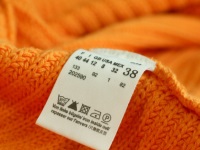
Improperly cared for clothing causes it to wear out quickly and lose its attractive appearance, so you should look carefully at the label on any garment before washing, drying, or bleaching it. There in the form of symbols indicate the nuances of care for a particular fabric.
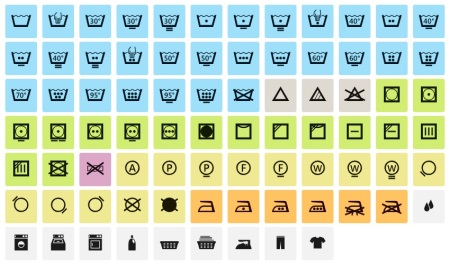
Washing
The basic care process for most types of clothing is washing. On the label sewn on the inside of the garment, you will see what kind of washing is recommended by the manufacturer, at what temperature the thing can be washed, and whether it can be bleached and wrung out.
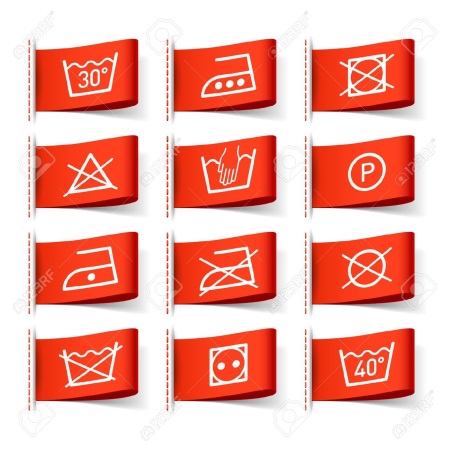
The sign, which will tell you how to wash this or that thing, resembles a basin of water. If your label shows only this "basin," then the thing is machine-washable on any program, that is, it is allowed both to soak and to spin.
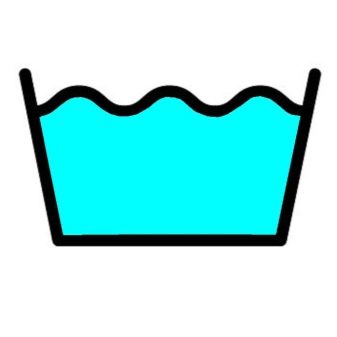
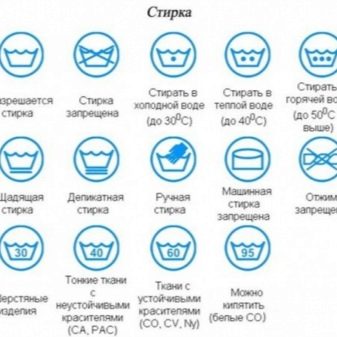
Other variations of such a sign deciphered as follows:
- Underlined with a single line "basin" indicates the need to use a gentle wash. Such a thing can not be washed on the program with a high number of revolutions, and to load the machine is advised only for 2/3 of the allowable volume of laundry.
- If under the "basin" you see two linesThe volume of the laundry should be reduced to 1/3 of the maximum recommended amount. The volume of laundry in the machine is advised to reduce to 1/3 of the maximum recommended. If you want to wash such a thing by hand, you should rinse such clothes in a large volume of water, and spin very carefully or not spin at all.
- "Basin" with a hand immersed in it indicates the need to wash such a thing with hands. The washing temperature in this case should not be higher than +40 C. In addition, such clothes should not be strongly rubbed and wrung out. As a rule, such a sign you will see on clothes made of guipure, chiffon, knitwear, satin and similar delicate materials.
- The image of a washing machine placed in a circle means a ban on machine washing. Such a designation is characteristic of fabrics that may fade, tear, or stretch while spinning in the drum. You will also see this icon on outfits with sequins, beads, rhinestones, and other decorations that can come off when washing in the machine.
- The crossed out "basin" tells you that this item should not be washed at all. Such a sign you will see on items that are taken to the cleaners, as even a gentle hand wash can damage them.
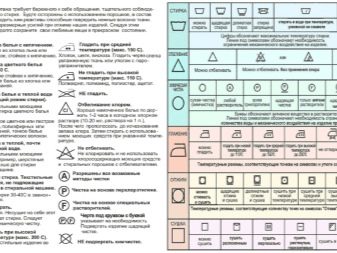
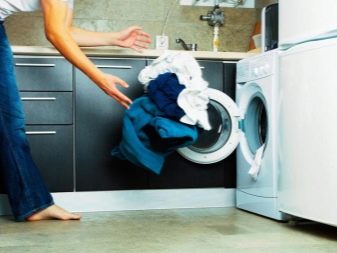
Temperature range
Pay attention to the water temperature symbol when washing is important that the thing did not sit down, did not lose its color and did not become shapeless.
About the allowable temperature you can learn from the two versions of the signs - inside the "basin" with water you will see either a number or dots in different numbers:
- 30º or 1 point - the thing is washed at a temperature no higher than +30º C, the spin should be minimal.
- 40º or 2 dots - for washing such thing, the temperature should not exceed +40ºC.
- 50º or 3 points - item may be washed at temperatures up to +50ºC.
- 60º or 4 points - for washing such a thing you set the temperature to +60ºC.
- 70º or 5 points - such thing can be washed at +70ºC.
- 95º or 6 points - such an item can be washed at a temperature of +95ºC.

Pressing
The wrong spin intensity may cause your clothes to shrink or become damaged.
The icon to tell you how to spin the garment is the following a square with a circle inside. Seeing such a sign, you can not worry that the thing is washed with a high spin intensity. In addition, such a designation allows the use of machine drying.

Other variants of a circle inside a square are deciphered as follows:
- If this sign is underlined with one line, for such a thing both spinning and drying in the machine should be sparing.
- If under the sign you see two lines, then such clothes should be washed on a program with a spin with a low number of revolutions, and the machine drying should also be gentle.
- If you see dots inside the circle in the square, that tells you the drying mode for that garment. Like the iron, the number of dots indicates the intensity of drying, for example, if there is one dot, the mode should be gentle, but if there are three dots, then drying can be fast and at high temperatures.
- If the circle inside the square is drawn, then heating during machine drying is inadmissible (clothes can only be treated with cold air).
- A crossed out square with a circle means that spin drying during washing and drying in a washing machine is forbidden.
- A crossed out image of a twisted garment indicates that such a thing must not be spun or washed.
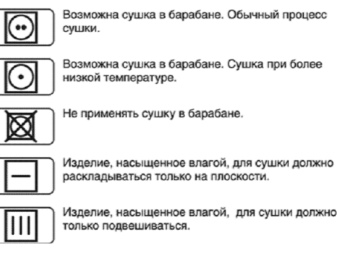
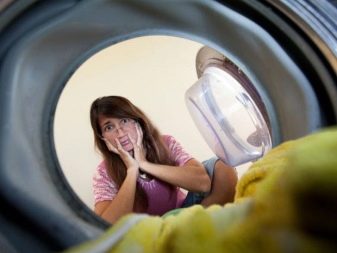
Machine Drying
Recommendations for drying clothes after washing are represented by a square sign. If you see just an empty square, such a thing can be dried.

Other variations of the square should be deciphered as follows:
- If an empty square is crossed out, such a thing cannot be dried.
- If a semicircle is shown at the top of the square, clothes are allowed to dry vertically - either on the shoulders or on the clothesline.
- Three vertical lines inside the square will tell you that the thing must not be wrung out, but should be hung up to dry still wet.
- One horizontal stripe inside the square indicates the need to dry on a horizontal surface, otherwise the fabric will deform and stretch. This is usually recommended for knitwear and wool.
- The two diagonal lines in the upper left corner of the square indicate a prohibition against drying in direct sunlight. Garments with this mark on the label should only be dried in the shade. Generally, these are white fabrics that turn yellow in the sunlight and colored fabrics that can fade.
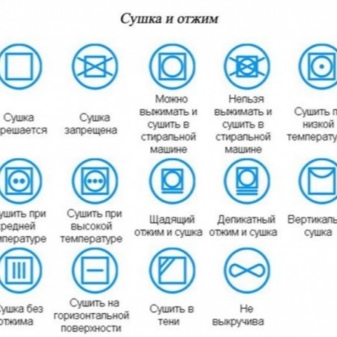

Bleach
Before you use bleach, be sure to look for the triangle on the label:
- If the triangle is there, bleaching is allowed.
- If such a triangle is crossed out, then bleaching is prohibited.
- Also pay attention to the letters inside - if you see "Cl" in the triangle, you can use bleaching products with chlorine.
- If the triangle with the letters "Cl" is crossed out, then bleaching is allowed, but chlorine-containing products cannot be used. A triangle with two diagonal lines inside has the same meaning.

No badges.
Although most clothes are marked with a washing symbol by the manufacturer, you will also see some clothes with labels that say so in English. You can decipher them as follows:
- Machine wash - Machine wash only.
- Hand wash only - The garment can only be washed by hand.
- Wash separately - Its colors are not resistant and can shed onto other clothing, so it must be washed in isolation
- Hot wash - Use hot water for warm washing.
- Warm wash - Wash the thing in warm water.
- Cold wash - The water must not be warm to wash such a thing
- No wash/Do not wash - This label warns you not to wash the garment.
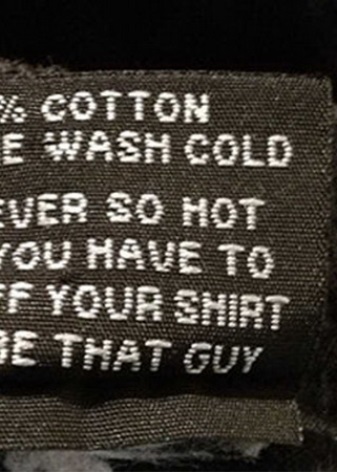
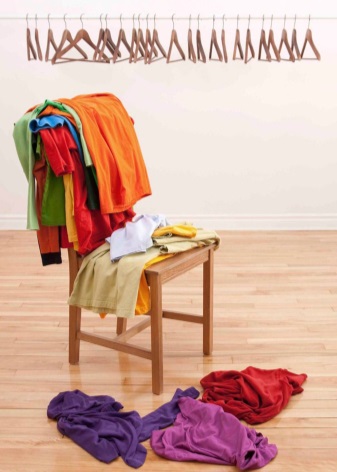
Dry clean
The dry cleaning label is mainly of interest to dry cleaners, because it shows exactly what kind of dry cleaning is allowed for a specific piece of clothing.
- The most important dry cleaning related label for the average person is the crossed out circle. It tells us that such clothes are not to be taken to the dry cleaners, because dry cleaning is contraindicated to them.
- The round symbol without any letters indicates that the object is dry cleaned. Often you will find such a sign on wool, leather, silk or suede clothing.
- If inside the circle there is a letterit tells you what chemicals are allowed to clean the fabric. It can be the letters A, F, P or W. And the dash under the circle will tell the dry cleaner that the treatment should be delicate.

Ironing
The fabric is exposed to high temperatures during ironing, that's why every producer marks on the label the optimum temperature mode depending on the fabric. For example, a linen or cotton cloth can be ironed with a very hot iron and using steam will only help smooth out the creases. If you overheat the iron when ironing synthetics or wool, the garment will be ruined.
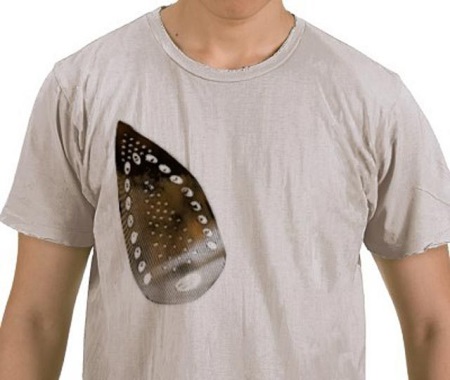
The ironing mode is shown on the label with a picture of the iron. If you see just If you see just an "iron" without any dots.then such a thing can be ironed with any heat as well as steamed. Other images of an "iron" decipher as follows:
- One dot inside the "iron" allows the iron to be heated to a maximum of 110ºC during ironing. This is gentle ironing, which is used mostly for synthetic materials such as viscose or polyamide.
- Two points inside the iron allow heating up to 150ºC. This temperature mode is used when ironing silk, polyester, wool.
- Three points inside the "iron" allow the iron to be heated to the highest temperature (+200ºC). This mode is usually selected for processing cotton and linen products.
- The "iron" inside the circle indicates an ironing temperature of up to 140ºC.
- The crossed out "iron" prohibits ironing the product. This designation is often found on terry cloth or nylon.
- If the legs of the "iron" are crossed out, then no humidification may be applied when ironing. Such a recommendation is usually found on the label of silk, satin and satin clothing, which must not be steamed.

Tips
All of the above designations are located on the label, which is a fabric tag. Such a label also indicates the clothing manufacturer, composition, and size of the garment.
Locate the label can be on the inside of the garment, looking at the inside seams of the product. On jackets, the tag is usually on the left side at waist level. On pants and jeans, the tag is sewn either on the back or on the side seam. On sweaters, shirts, T-shirts, and other lightweight clothing, the tag can be found either on the side seam or under the collar at the back.

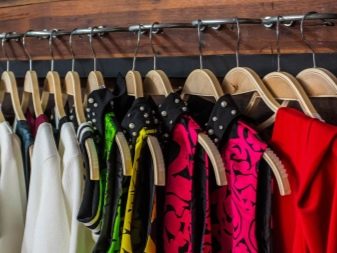
To reinforce everything you've read, watch an informative, fun and easy-to-understand video from the author of the Abalade Channel:




